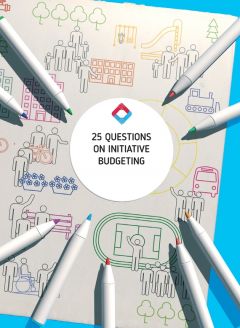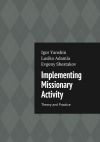Текст книги "25 Questions on Initiative Budgeting: manual"

Автор книги: Коллектив авторов
Жанр: Управление и подбор персонала, Бизнес-Книги
Возрастные ограничения: +16
сообщить о неприемлемом содержимом
Текущая страница: 1 (всего у книги 3 страниц)
25 Questions on Initiative Budgeting: manual
Kudrin Foundation for the Support of Сivil Initiatives
Composite Authors:
V. V. Vagin (author, supervisor of studies)
E. A. Timokhina (head of the publishing project)
N. V. Gavrilova
N. A. Shapovalova
A. Yu. Fenin
I. S. Antsyferova
Question 1
What is initiative budgeting (IB) and what is it for?
IB is a set of diverse practice based on the citizens’ initiative to address issues of local importance with the direct participation of citizens in determining and selecting objects for spending budgetary funds, as well as subsequent monitoring of the implementation of selected projects.
At the same time, IB is a mechanism for determining priorities in spending budgetary funds with the participation of initiative groups of citizens.
Currently, in many countries, projects that meet the criteria for initiative budgeting are being implemented. The most important features include, in particular:
• participation of citizens at all stages of project implementation;
• distribution of funds of municipal and state budgets;
• regularity and annual repeatability of projects;
• public reporting on the implementation of projects.
Initiative budgeting is a part of the worldwide trend of increasing the scale of participation of territorial communities in determining the ways to develop their own settlements. In the EU countries, this phenomenon was called Community-led Development (CLD).
In each country, the involvement of citizens takes place in different ways, but everywhere the main goal is the participation of citizens in the decisionmaking process. This is especially important when decisions directly affect regional communities.
It is obvious that people are much more aware of the majority of problems of their settlements and, of course, the choice of citizens is more justified than the decision of the authorities. Unfortunately, the choice of authorities, without its discussion and approval by citizens, often leads to mutual rejection and growing hostility.
Question 2
How does initiative budgeting begin?
Initiative budgeting is the Russian version of the well-known participatory budgeting (PB), participation of citizens in budget decisions, which appeared in the late 1980s in Brazil. The emergence of PB practice was a response to the need for joint work of citizens and representatives of the authorities in solving urban problems. The emergence of PB became possible due to a combination of factors, such as the political will of the new government, its desire for democratization and the availability of support from below, from citizens willing to change the situation in their settlements.
Porto Alegre, a million city, the capital of the most southerly state of Brazil, Rio Grande do Sul, became a springboard for the implementation of the first major PB experiment. It is this most important administrative center of the region which is considered to be the starting point of the history of participatory budgeting. Porto Alegre found itself in the forefront of the progressive trend for a reason. The new left wing of the local government has shown itself to be strong enough to take advantage of the opened opportunities and organize the PB process. The catalyst was the oncoming urban movement from below by civil society.
The economic and social context of the reforms was similar to the situation in other large cities in Brazil. Port Alegre had a third of the population living in slums with limited access to clean water, sanitation, hospitals and schools. Reforms started in 1989 were aimed at overcoming these very acute problems. The PB became one of the mechanisms for their implementation. In 1989–2004, the PB practice was sufficiently entrenched and institutionalized.
Since the experience of Porto Alegre was successful, it began to replicate. At first it happened inside Brazil, and then it was transferred to other countries of Latin America. In 1996, at the UN Habitat conference in Istanbul, the PB was recognized at the international level as one of the best social practices. The following years were marked by active dissemination of practice in different countries.
IB Practices in the World

Reference
Brief History of the Development of Participatory Budgeting (PB) in the World over the Past More than 25 Years
The history of the emergence and evolution of PB around the world can be represented in five consecutive stages:
• The first stage includes the 1989 and 1997 experiments in Porto Alegre (Brazil) and Montevideo (Uruguay). It partially coincides with the terms of office of the two governments in Brazil in 1989–1992 and 1993–1996, when more than 30 municipalities launched their PB experiments. Rapid urbanization and an increase in the number of poor urban population, which was not provided with the necessary infrastructure, contributed to the emergence of PB. At the same time, there was a liberalization of the political trend in Brazil, which opened the window for reforms.
• The second stage coincides in time with the term of office of the next Brazilian government in 1997–2000, during which more than 140 municipalities began to implement the PB methodology, although with significant differences.
• The third phase began after the 2000s, when PB experiments began to be conducted outside of Brazil in various Latin American and European cities. Their initiators were inspired by the successful example of Porto Alegre and tried to implement something similar adapting the methodology to the realities of their locality. Appearing as an initiative of the left parties, the PB was recognized as an effective “good governance” practice and was widely distributed in isolation from the left ideology.
• The fourth stage began in 2007–2008 along with a new trend: there were PB professional communities in Brazil, Colombia, Argentina, Spain and Germany. There were initiatives such as the Chilean PB Forum, the Portuguese Participatory Budget Initiative, the British PB Unit, the American Participatory Budgeting Project and others. A distinctive feature of this stage is the formation of experts and organizations having PB knowledge.
• The fifth stage is related to the integration of PB practices into more complex systems of citizens’ engagement. Most likely, this trend will intensify in the coming years.
According to different estimates, as of 2012, more than 2,000 PB projects have been implemented worldwide with 40 to 50 % of all projects being implemented in Latin America.
Question 3
What is Initiative Budgeting Practice?
The IB practice is a program implemented within the framework of one region of the Russian Federation aimed at involving citizens in the budget process and participation of citizens in budget decisions. In other words, it is activities similar in their program and design, aimed at addressing issues of local importance, with the help of allocated budgetary funds for this purpose.
The most famous practices of initiative budgeting in Russia are: the World Bank Local Initiative Support Program (PPMI), Participatory Budgeting(European University in Conjunction with the Committee of Civil Initiatives [CCI]), People’s Budget, and People’s Initiative in various regions of Russia.
The PPMI has been implemented in Russia since 2007 and is recognized as one of the best social programs of the World Bank. Within the framework of the program, about 4000 projects have been implemented in eight regions of the Russian Federation: the Stavropol Territory, the Kirov, Tver, Nizhny Novgorod Regions, the Republic of Bashkortostan, the Khabarovsk Territory, the Republic of North Ossetia-Alania, and the Jewish Autonomous Region.
The distinctive features of this practice are the participation of citizens in the selection of priority projects, the implementation and monitoring of projects, co-financing.
Participatory budgeting works in several municipalities of the Leningrad, Vologda, and Kirov Regions. Unlike PPMI, this practice does not imply the co-financing of projects by citizens. Members of budget commissions selected by drawing lots among interested citizens discuss which decisions have a priority to be implemented.
People’s Budget and People’s Initiative (s) are programs initiated by the All-Russian Political Party “Edinaya Rossia” (United Russia) and the National Front (ONF) during the 2010–2011 elections. Dozens of Russian regions declared their participation. More than 80 billion rubles were allocated within the framework of these practices. Unfortunately, these practices did not develop in the following years, and most of the regional programs were closed.
Currently in Russia there is an active search for new practices of initiative budgeting, first of all, the practices of involving urban citizens in initiative budgeting.
Reference
Basic Model of Involvement in the Budgetary Process
Ladder of participation:
1. Passive participation.
2. Access to information.
3. Consultations.
4. Joint decision-making.
5. Initiation and control by those who receive the result from social changes.
6. Formation of self-motivation for action (the highest form of involvement).


Question 4
What is the algorithm of initiative budgeting?
From country to country, from region to region, the mechanisms for involving citizens in the budget process are somewhat different. In its most general form, the algorithm provides for the following stages:
• According to the decision of the regional government body, the amount of budgetary funds for the initiative budgeting program is determined.
• The design of the IB practice, its calendar cycle is determined, appropriate orders, regulations and resolutions are adopted. In rare cases, changes are made in the regional legislation.
• Public discussions are organized where citizens formulate and discuss ideas to solve the most pressing problems for them. In these discussions, citizens exchange opinions, formulate their own proposals and learn about other proposals. It is important for everyone to have an opportunity to express their views on the priorities of spending.
Then, with the participation of a consultant, there is a dropout of those ideas that do not correspond to formal criteria (minimum and maximum cost of project implementation, property issues, authorities).
Then the vote takes place, where from the remaining short list citizens select the most important ideas.
• With the support of consultants and representatives of the municipal government, initiative groups work on ideas with the largest number of votes casted, and prepare project documentation for them.
• Implementation of projects is provided with financing. In some practices of initiative budgeting, a contest is envisaged: not all projects put forward by citizens are provided with financing, but only those that score the most points according to the formulated criteria. Another feature is the co-financing of projects by citizens, the amount of which is determined by the citizens themselves at the same meeting.
• Under the standard state procurement procedure, contractors responsible for the practical implementation of projects are selected.
• Projects are implemented under the control of citizens.
Question 5
What is the maximum cost of the project, which can be implemented with the help of IB?
The cost of initiative budgeting projects is much less than the cost of investment projects. It should be remembered that the main area of application of initiative budgeting in Russia is the solution of local issues.
Reference
Most practices of initiative budgeting introduce restrictions on the upper limit of the amount of state funding. For cities, it is 2 million rubles, for villages – up to 1 million rubles. At the same time, along with state funds for the implementation of projects, funds from municipalities, citizens and businesses are attracted.
The amount of co-financing of funds from these sources is not limited. In general, in the Russian Federation, co-financing reaches a third of project implementation costs. In the Stavropol Territory, Rodnikovskoye Village, Arzgir District, over 20 million rubles were co-financed from the funds of the municipality and business for the repair of the school sports hall.
The average cost of PPMI micro projects in the Tver Region is a little more than 700 thousand rubles. In 2016, the program as a whole in the region was allocated 165 million rubles.
Thus, the amount of subsidy for a separate initiative budgeting project depends on the design of the program adopted in the constituent territory of the Russian Federation.
Question 6
Who implements IB projects? Can I get money from the budget for the implementation of the project, which will be selected?
Citizens who chose the initiative budgeting project and are involved in its development are also actively involved in monitoring the implementation of the project. At the same time, the works are put for competition in accordance with the provisions of the Federal Law No.44-FZ “On Contract System for the Procurement of Goods, Works, Services for the State and Municipal Needs” dated 05.04.2013 (as amended on 03.07.2016) or the Federal Law No.223-FZ “On Procurement of Goods, Works, and Services by Certain Types of Legal Entities” dated 18.07.2011 (as amended on 05.04.2016).
The law gives an opportunity to participate in the competition to a wide range of persons. A participant, who has collected the most points and, as a rule, has offered the least amount to fulfill the contract, starts work in accordance with the work schedule.
Thus, the implementation of works within the IB projects is carried out by the winner of the official competition held in accordance with the norms of federal legislation.
Question 7
What share of the local budget is distributed through the IB mechanism?
In the city of Porto Alegre, in some years, up to 40 % of the city budget was distributed through the practice of initiative budgeting. On average, at least 10 % are allocated to PB projects annually.
In Russia, regional practices of initiative budgeting rarely exceed 1 % of total budgetary expenditures. Exceptions are several regions. In 2016, the Yaroslavl Region started the implementation of the program “Develop the Region by Anniversary”, for which it was envisaged to allocate over 1.6 billion budgetary funds. This amount is almost 2 % of the regional budget. It is gratifying that most of the projects are implemented on the basis of decisions and participation of citizens.
It will be appropriate to draw attention to the fact that the minimum amount of the pilot program of a constituent territory of the Russian Federation should be above 20–30 million rubles. Otherwise, it is difficult to determine and assess the effects of initiative budgeting: projects are few, there are a large number of losers in the competition, and the costs of consulting projects are high.
Question 8
Can IB be implemented in cities?
Initially, projects involving citizens were mainly implemented in cities. In Latin America, most cities with over one million people have experience in participatory budgeting. In Europe, PB is also predominantly urban practice. Lisbon, Paris, Berlin – this is not a complete list of cities implementing PB projects.
At the same time, in South-East Asia, PB is predominantly rural practice.
In Russia, initiative budgeting is concentrated in villages, urban-type settlements and small towns. At the same time projects of participatory budgeting are city projects. The PPMI also attempts to develop an urban component. Tver, Kirov and Ufa are actively involved in this process.
It should be noted that urban practices can differ significantly from rural ones. Due to the larger size of the settlements, the urban population is disjointed: it is difficult and sometimes impossible to gather it for a general meeting, without the decision of which it is impossible to take a lawful decision (Federal Law No.131-FZ “On General Principles of the Organization of Local Government in the Russian Federation’ dated 06.10.2003 [as amended on 03.07.2016]).
The urban population is accustomed to new payment technologies through an online bank, crowded funds, voting and participation through a variety of Internet platforms. Developers of city practices are required to take all this into account when drawing up the design of urban programs for initiative budgeting. Moreover, the absence of such elements in urban practices will scare the city people.
Reference
Information Technology Serving the IB. Review of Foreign Experience and Prospects for Use in Russia
In the foreign experience of the past few years, the Internet is used almost everywhere: as a minimum, to inform about passing offline activities through websites and social networks, as a maximum, for organizing procedures for discussion and voting for projects.
Brazil was among the pioneer countries using methods based on digital technologies to attract new participants. This happened already when, in many other countries, the PB, as practice, did not yet exist. The municipality of Belo Horizonte was one of the first to gather its citizens for full-time meetings by sending electronic newsletters, placing advertisements in popular blogs and on electronic pages of the city’s districts and providing an opportunity to invite friends to vote via e-mails using the site. Subsequently, the city completely switched to the format of discussions and voting on the Internet. The first known case of the use of mobile phones in the framework of the PB occurred in 2004 in the city of Ipatinga, Brazil.
In Europe, the first projects with Internet participation were implemented in Germany. Today, one of the most ambitious European urban PB projects based on Internet involvement is implemented in Paris. The experience of Reykjavik, the capital of Iceland, is interesting, where they came up with their own format for structuring Internet discussions dividing the screen into two parts: with the arguments “for” and “against” the idea.
In Asia, South Korea’s practice deserves special attention, where in 2007 the Digital Budget and Accounting System (d-Brain) was launched. This system provides online analysis of tax activity of the government, including the issues of budgeting, its execution and productivity management, which makes fiscal policy more effective. In some South Korean cities, the d-Brain system offers a valuable tool for electronic PB. In cities where citizens do not have common spaces for decision-making, they can control the budget process through Internet surveys, online voting, forums and public hearings on the Internet.
In Russia, the Internet is used mainly to inform and automate the processing of applications. The format of Internet voting on budget issues is a matter of the future.
Question 9
What is the mechanism of citizens’ participation?
Participation of citizens in the distribution of budgetary funds can be organized in three key ways:
1. All citizens participate in the formation of ideas and the selection of priorities.
In the practice of the Local Initiative Support Program (PPMI) in rural settlements where the population is not so great, the full-time gatherings are held where most of the local citizens take part. In many foreign countries, especially in large cities, where it is physically impossible to gather a representative number of citizens for a full-time meeting, the channels of distance participation are actively used – telephone and the Internet, through which citizens can discuss the problems of the community without leaving their homes. Other, less common channels can be used to ensure inclusive participation. For example, as part of the PB youth project in Boston, the ideas were collected from teenagers in places where they most often gather: in schools, parks, supermarkets, transport hubs. In the city of Sopot, Poland, citizens were asked to vote for projects at polling stations. In the city of Belo Horizonte, Brazil, mobile voting stations operated: the bus moved to those areas of the city where the possibility of citizens’ participation in alternative ways was limited.
2. In the determination of budgetary expenditures, a commission selected by drawing lots is involved. In large settlements where it is quite labor-intensive to organize total involvement, the procedure can be democratized by drawing lots. The team of Res Publica Center of the European University in St. Petersburg, which, with the support of the Committee, implements citizens’ initiatives in the cities of Sosnovy Bor and Cherepovets and in several settlements of the Kirov Region, organizes the participation procedure as follows: an information campaign is conducted; those wishing to participate in the draw send applications for participation in the budget commission; on the appointed day, a draw with the participation of citizens and the media is openly held; the budget commission formed in this way further works on the selection of projects.
3. The commission of delegates from the community participates in the determination of budgetary expenditures. This design option today is practically not used, but when the PB first appeared in Porto Alegre it was implemented in this format: the citywide budget commission included elected representatives from each district
Participation in IB is Mutually Beneficial










































